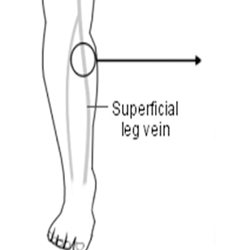Varicose Veins Treatment in Pune
Understanding Varicose veins
There are no accurate figures for the number of people with varicose veins. Some studies suggest that 3 in 100 people suffer from them at some time in their lives. Most people with varicose veins do not have an underlying disease and they usually occur for no apparent reason.
Understanding normal leg veins
Veins are blood vessels which take blood back to the heart. Blood flows up the leg veins, into larger veins and towards the heart.

There are three types of veins in the legs:
- Superficial veins, which are the ones just below the skin surface. You can often see or feel the larger superficial veins. The superficial leg veins are the ones that may develop into varicose veins.
- Deep leg veins, which pass through the muscles. You cannot see or feel these.
- Many small communicating (perforator) veins, which take blood from the superficial veins into the deep veins.
There are one-way valves at intervals inside the larger veins. These valves prevent blood flowing back in the wrong direction. When we stand there is quite a height of blood between the heart and legs. Gravity tends to pull the blood back down but is prevented from doing so by the vein valves and by the normal flow of blood towards the heart.
What are varicose veins?
Varicose veins are enlarged (dilated) sections of veins which are located just under the surface of the skin – usually on the leg. They are often easy to see, as they look thick and knobbly. They may be less obvious if you are overweight, as they are hidden by fatty tissue under the skin.
Other, smaller types of veins which can be noticeable are:
- Reticular veins – a closely grouped network of small veins.
- Thread veins, or spider veins – these look like a kind of star burst pattern on an area of the leg. They are not true varicose veins.

What are the symptoms of varicose veins?
Most people with varicose veins have no symptoms. Some people are concerned about the appearance of the veins. Larger varicose veins can ache, feel heavy or itch.

Are there any complications of varicose veins?
Possible complications include:
Inflammation of the vein (thrombophlebitis).
Swelling of the foot or lower leg.
Skin changes over the prominent veins. The possible skin changes are discolouration,varicose eczema, skin ulcers, or lipodermatosclerosis (hardening of the fat layer under the skin, causing areas of thickened, red skin). See separate leaflet called Venous Leg Ulcers, which explains about skin ulcers caused by varicose veins.
Rarely, varicose veins may bleed.
Do I need treatment or a referral for varicose veins?
Most people with varicose veins do not need any treatment. You may want to have treatment for one of the following reasons:
If complications develop
These occur in a small number of cases. If leg swelling or skin changes develop over prominent veins, treatment is usually advised to prevent a skin ulcer from developing. If a skin ulcer does occur then treatment of any varicose veins may help to cure the ulcer. If you have a varicose vein which has bled, you should be referred urgently for treatment.
For symptoms
itch or discomfort.
Cosmetic reasons
Which tests might I have?
If varicose veins are problematic, you will usually be referred for assessment by a doctor who is a specialist. You may have a type of ultrasound scan called a Doppler or a duplex scan. This helps to show how the blood is flowing in the veins. It can show whether any of the valves are damaged – which is useful to know when planning treatment. Occasionally, other tests are needed if the veins are complex.
What are the treatment options for varicose veins?
There are several different options. Traditional operations such as vein stripping have largely been replaced by procedures which involve heat, lasers or the injection of chemicals into the vein.
Radiofrequency ablation and endovenous laser ablation
These methods involve passing a probe into one of the longer varicose veins, using ultrasound to guide the position. The laser or radiofrequency energy makes the vein heat up, which seals it.
Foam sclerotherapy
This technique is used if heat or lasers do not work. It uses a chemical mixed with air to make foam. The foam is injected into the veins, pushing the blood away and making the veins go into spasm. After treatment, compression stockings are needed,and the veins will be hard and swollen for a while before they shrink down. More than one treatment may be needed
Surgery
Traditional surgery is recommended if treatment with heat, lasers or foam does not work.
